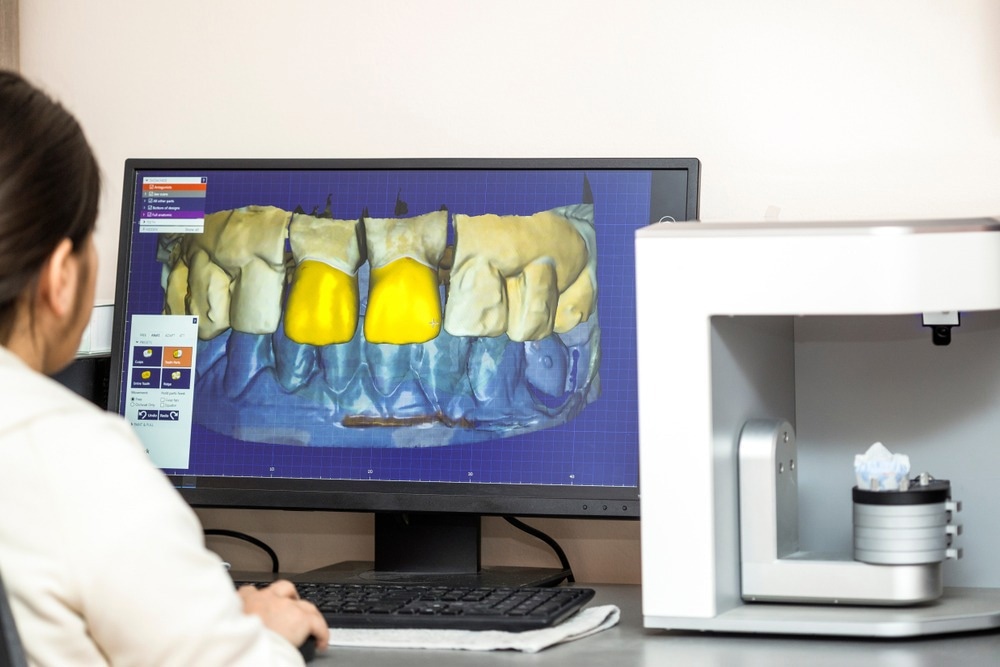 By Surbhi JainReviewed by Susha Cheriyedath, M.Sc.Jul 13 2022
By Surbhi JainReviewed by Susha Cheriyedath, M.Sc.Jul 13 2022In an article recently published in the journal Additive Manufacturing, researchers discussed the printing of ceramic composite in three dimensions with a biomimetic toughening design.

Study: 3D printing of ceramic composite with biomimetic toughening design. Image Credit: bymandesigns/Shutterstock.com
Background
Creating damage-tolerant ceramic composites has been thought to be effective in mimicking the brick-and-mortar structure of nacre. Despite the fact that nacre-inspired ceramic composites have good characteristics, bioinspired composites' discontinuous ceramic phase causes stress concentrations at the soft/hard interface, which lowers their load-bearing capacity.
Therefore, research into bi-continuous phase ceramic composites is anticipated. Damage-tolerant interpenetrating phase composites (IPCs) have been the subject of several studies up to this point.
Damage-tolerant ceramic composites with complex geometries or unique designs are in high demand for a variety of applications. However, due to the limitations on mold shape, conventional processing techniques like ice templating or freeze casting are unable to provide geometrical freedom for the manufacturing of ceramic composites. Using 3D printing, also known as additive manufacturing, has created new possibilities for creating ceramic composites with intricate geometrical structures.
Digital light processing (DLP) is gradually becoming the top AM technique for manufacturing high-performance, geometrically flawless, defect-free parts with a tolerable level of precision and a passable level of surface quality. Due to their exceptional chemical and mechanical stability, damage-tolerant ceramics with high toughness are essential for a wide range of practical applications. However, current processing techniques make it impossible to produce parts with complex or customized geometries due to mold shape limitations.
About the Study
In this study, the authors discussed a promising technique for the creation of geometrically challenging ceramic composite parts with outstanding damage tolerance by using additive manufacturing (AM) and cutting-edge biomimetic toughening design. As-fabricated ceramic composites were used to provide extraordinary gains in toughness that were 116 times similar to those of pure ceramics, avoided catastrophic failure, and had unique geometries that could not be produced using standard methods.
The team proposed a viable strategy for the utility of additive manufacturing to create ceramic composites having bi-continuous zirconia/epoxy phases that were geometrically challenging and damage-tolerant. Due to its widely-known triply periodic minimal surface (TPMS) structure and large surface area, which was inspired by the dactyl club, it was specifically chosen as a continuous ceramic scaffold.
The researchers made the proposed scaffolds by using a homemade digital light processing (DLP) printer and were then infiltrated with an epoxy polymer which acted as the soft phase. Such bioinspired composites demonstrated exceptional tolerance to damage in terms of toughness. There was a demonstration of one unique application in dental restorations.
Observations
In restorative dentistry, IPCs with 75 vol.% zirconia were constructed as dentin of posterior or anterior pontic bridges. The dense zirconia could also be employed as hard outer enamel. While the graded ceramic wall thickness increased linearly from 0.3 to 0.7 mm, which resulted in a graded stress distribution with peak stress concentrations around the upper surface, the ceramic wall thickness of 34.6 vol % uniform composites was maintained at 0.5 mm.
As a result, compressive stress dispersed uniformly in the ceramic structure. As a result, the composite's graded scaffold was gradually broken along the compressive direction as the strain incremented from 0.2 to 0.6, while the fractures were spread into the thicker surface.
Experimental results revealed that the strength in uniform and graded composites increased by 84 and 213%, respectively, when compared to the as-sintered ceramic, whereas Young's modulus was only slightly increased. Additionally, it was discovered that the hardness of both uniform and graded composites significantly increased by 30 and 116 times, respectively.
Conclusions
In conclusion, this study elucidated a potential technique for the creation of complex geometries of damage-tolerant ceramic composites using 3D printing and innovative biomimetic design. The bi-continuous architecture of mantis shrimps, which was imitated, provided the produced ceramic composites with extraordinary toughness and load-bearing capacity.
Experimental and theoretical research was done to examine the biomimetic structure's toughening mechanisms. The authors mentioned that the created composites have enormous potential for dental restorations. More importantly, they anticipated that the proposed strategy could be expanded to the fabrication of additional high-performance engineering materials, opening the door to novel applications in a wide range of industries, including tissue engineering, the automotive and aerospace industry, and energy devices.
The authors also stated that these AM-processed bioinspired ceramic composites open up interesting possibilities for applications that call for personalization.
Disclaimer: The views expressed here are those of the author expressed in their private capacity and do not necessarily represent the views of AZoM.com Limited T/A AZoNetwork the owner and operator of this website. This disclaimer forms part of the Terms and conditions of use of this website.
Source:
Sun, J., Yu, S., Wade-Zhu, J., et al. 3D printing of ceramic composite with biomimetic toughening design. Additive Manufacturing 103027 (2022). https://www.sciencedirect.com/science/article/abs/pii/S2214860422004195